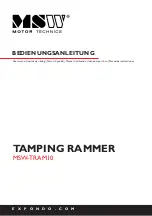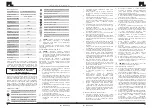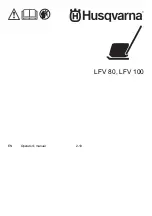
10
11
Rev. 27.06.2022
Rev. 27.06.2022
3. USE GUIDELINES
The tamping rammer is used for compacting soil on roads,
embankments and reservoirs, before ground construction
works and after completion of underground installation
works.
The user is liable for any damage resulting from
unintended use of the device.
3.1. DEVICE DESCRIPTION
d) Keep the device in perfect technical condition.
Before each use check for general damage and
especially check for cracked parts or elements and
for any other conditions which may impact the safe
operation of the device. If damage is discovered,
hand over the device for repair before use.
e)
Keep the device out of the reach of children.
f)
Device repair or maintenance should be carried out
by qualified persons, only using original spare parts.
This will ensure safe use.
g)
To ensure the operational integrity of the device, do
not remove factory-fitted guards and do not loosen
any screws.
h)
When transporting and handling the device between
the warehouse and the destination, observe the
occupational health and safety principles for manual
transport operations which apply in the country
where the device will be used.
i)
Do not leave this appliance unattended while it is in
use.
j)
Clean the device regularly to prevent stubborn grime
from accumulating.
k)
The specified vibrations emission was measured
using standard measurement methods. Vibrations
emissions may change if the device is used in
different surroundings
l)
The device is not a toy. Cleaning and maintenance
may not be carried out by children without
supervision by an adult person.
m) It is forbidden to interfere with the structure of
the device in order to change its parameters or
construction.
n)
Keep the device away from sources of fire and heat.
o) During operation, the device generates vibrations
and requires repetitive activities that may be harmful
to user's hands and shoulders.
p) The user and the machine should be in a stable
position on level ground. Make sure that the machine
does not tip over, slip or fall during operation or
when left unattended.
q)
Before using the device near excavation, make sure
that excavation walls are stable and will not collapse
under vibration.
r)
Make sure that there are no live electrical cables, gas,
water or other telecommunication infrastructure in
the area to be compacted because they may become
damaged by vibrations.
s)
Do not stand on the device, whether it is currently in
use or not.
t)
Slipping, tripping or falling are the main causes
of serious injury or death. Be careful of uneven or
slippery working surfaces as well as unprotected
holes and excavations.
u)
Use proper protective clothing and footwear when
working with hot bituminous mixtures.
v) The device is heavy and should be moved and
positioned by two sufficiently strong people. Use
the handles on the machine and proper heavy-lifting
techniques.
n)
Stay away from moving and rotating parts as they
may cause injury.
o)
Do not use the machine if all protective covers are
not installed.
p)
Do not increase the engine speed above 3500 rpm
without more a load. Any increase may result in
injury or damage to the device.
q) Do not touch the silencer or other hot elements
when the engine is hot it may cause serious burns.
r)
Make sure that petrol is stored only in certified
containers (e.g. canister).
s)
Do not refuel near sparks, flames or lit cigarettes.
t)
Stop the engine before refuelling. Never refuel while
the engine is running or is still hot. Otherwise, spilled
or evaporated fuel may catch fire from engine sparks
or silencer heat.
u)
Do not overfill fuel tank and avoid spilling petrol
while refuelling. Spilled petrol or petrol fumes may
catch fire. If petrol has been spilled, make sure that
the area is dry before starting the engine.
v)
After refuelling, make sure that the fuel tank cap is
properly screwed on.
w) Do not operate the engine or refuel petrol in
enclosed areas without appropriate ventilation.
x)
Avoid operating the machine in enclosed spaces,
tunnels or other poorly ventilated places as the
exhaust fumes contain lethal/harmful fumes and
gases. If operating the machine in such conditions is
unavoidable, provide adequate exhaust extraction.
y)
To transport: Stop the engine. Close and secure the
fuel tank cap. Switch the fuel valve to the “OFF-O”
position. Drain the fuel tank before long-distance
transportation or on bumpy roads.
z)
Keep flammable materials (petrol, matches, straw,
etc.) away from the exhaust.
2.2. SAFETY IN THE WORKPLACE
a)
Make sure the workplace is clean and well lit. A messy
or poorly lit workplace may lead to accidents. Try
to think ahead, observe what is going on and use
common sense when working with the device.
b) Do not use the device in a potentially explosive
environment, for example in the presence of
flammable liquids, gases or dust. The device
generates sparks which may ignite dust or fumes.
c) If you discover damage or irregular operation,
immediately switch the device off and report it to
a supervisor without delay.
d)
If there are any doubts as to the correct operation
of the device, contact the manufacturer's support
service.
e)
Only the manufacturer's service point may repair the
device. Do not attempt any repairs independently!
f)
In case of fire, use a powder or carbon dioxide
(CO
2
) fire extinguisher (one intended for use on live
electrical devices) to put it out.
g)
Children or unauthorised persons are forbidden to
enter a work station. (A distraction may result in loss
of control over the device).
h) The device produces dust and debris during
operation. It is important to protect bystanders from
their harmful effects.
i)
Use the EMERGENCY STOP if there is a risk of injury
or death, accident or damage.
j)
Regularly inspect the condition of the safety labels. If
the labels are illegible, they must be replaced.
k) Please keep this manual available for future
reference. If this device is passed on to a third party,
the manual must be passed on with it.
l)
Keep packaging elements and small assembly parts
in a place not available to children.
m) Keep the device away from children and animals.
n) If this device is used together with another
equipment, the remaining instructions for use shall
also be followed.
2.3. PERSONAL SAFETY
a)
Do not use the device when tired, ill or under the
influence of alcohol, narcotics or medication which
can significantly impair the ability to operate the
device.
b)
The machine may be operated by physically fit
persons who are able to handle the machine, are
properly trained, who have reviewed this operating
manual and have received training in occupational
health and safety.
c) The machine is not designed to be handled by
persons (including children) with limited mental
and sensory functions or persons lacking relevant
experience and/ or knowledge unless they are
supervised by a person responsible for their safety
or they have received instruction on how to operate
the machine.
d)
When working with the device, use common sense
and stay alert. Temporary loss of concentration while
using the device may lead to serious injuries.
e) Use personal protective equipment as required
for working with the device, specified in section 1
(Legend). The use of correct and approved personal
protective equipment reduces the risk of injury.
f)
Do not overestimate your abilities. When using the
device, keep your balance and remain stable at all
times. This will ensure better control over the device
in unexpected situations.
g)
Do not wear loose clothing or jewellery. Keep hair,
clothes and gloves away from moving parts. Loose
clothing, jewellery or long hair may get caught in
moving parts.
h) Remove all adjusting tools or spanners before
turning the device on. A tool or spanner left in the
revolving part of the device may cause injury.
i)
Use eye, ear and respiratory protection.
j)
The device is not a toy. Children must be supervised
to ensure that they do not play with the device.
2.4. SAFE DEVICE USE
a) Do not overload the device. Use the appropriate
tools for the given task. A correctly-selected device
will perform the task for which it was designed better
and in a safer manner.
b)
Do not use the device if the ON/OFF switch does not
function properly (does not switch the device on and
off). Devices which cannot be switched on and off
using the ON/OFF switch are hazardous, should not
be operated and must be repaired.
c)
When not in use, store in a safe place, away from
children and people not familiar with the device who
have not read the user manual. The device may pose
a hazard in the hands of inexperienced users.
REMEMBER!
When using the device, protect
children and other bystanders.
ATTENTION!
Despite the safe design of the device
and its protective features, and despite the use of
additional elements protecting the operator, there is
still a slight risk of accident or injury when using the
device. Stay alert and use common sense when using
the device.
EN
EN
11
8
7
12
9 10
18
17
16
15
14
13
5
2
3
4
6
1






















